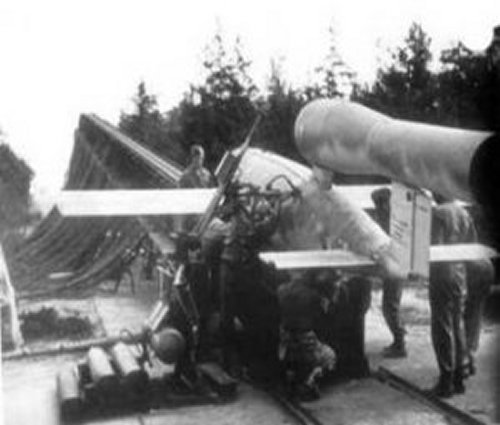
In Service: 13 June 1944 to 1945
First Flight: Manufacturer: Fieseler Number built: 30,000 plus
Type: Surface-to-Surface Missile Guidance system: gyrocompass based autopilot Length: 7.9 m Wingspan: 5.3 m Diameter: m Weight: 2,180 kg Engine: 1 × Argus As 109-014 pulse jet engine producing up to 300 kg of thrust Maximum speed: 645 km/h Range: 370 km Warhead: 850 kg Amatol 39 Fuze: Launch Platform: Fixed, later He 111 Operators: Luftwaffe Variants: Fieseler Fi 103 Fieseler Fi 103R Other: Missiles Articles: German rocket draws gawkers on I-5
The Fieseler Fi 103 or more commonly known as the V-1 flying bomb was designed as a (Vergeltungswaffe 1) retaliation weapon by Germany during the Second World War. The V-1 was known by many names Buzz bomb, Doodlebug, Flying Bomb, Robot Bomb, Fieseler Fi 103. The V-1 was developed at Peenemünde by the Luftwaffe during the World War II. The V-1 flying bomb was the first of Germany's vengeance weapons (Vergeltungswaffen) designed to wreak absolute terror and havoc on Great Britain, The Fieseler Fi 103 was fired from prefabricated launch sites along the French and Dutch coasts, the first V-1 flying bomb attack came on the 13th of June 1944 on London a week after D-Day, at its highest over 100 V-1 flying bombs were launched a day at southeast England more than 9,000 were launched against the United kingdom. As the Allied forces overran Europe, Germany lost its launching sites and the last V-1 was fired in October 1944. Robert Lusser of the Fieseler aircraft manufacturer and Fritz Gosslau from the Argus engine manufacturer designed the Fieseler Fi 103 under the codename Kirschkern, the construction of the fuselage was mainly welded sheet steel and the wings were built in the same manner but if resources were short then plywood, could and was often used. The first complete V-1 airframe was delivered 30th of August 1942, and soon after the Argus 109-014 was delivered. The first aerial tests started on the 28th of October 1942 with the first unpowered flight at Peenemünde, after being fitted beneath a Fw 200 (Kondor). And on the 10th of December 1942 the first powered flight was undertaken, but this time the He 111 was used to piggyback the Fieseler Fi 103.
This clip shows the Fieseler Fi 103, V-1 Flying bomb in-flight and exploding on the ground this is probably a test flight.
The Warplanes of the Third Reich. ISBN-10: 0385057822 German Aircraft of the Second World War. ISBN-10: 0370000242 Hitler's Luftwaffe. ISBN-10: 051718771X For a complete list of sources
|
| ||||||||||||||||||||||||||||






